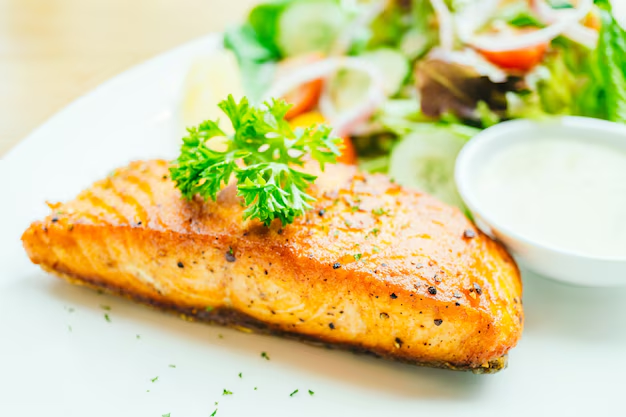How to Keep Your Cooked Salmon Fresh: Refrigerator Tips & Tricks
Salmon, with its rich flavors and impressive health benefits, is a favorite in many households. Whether you’ve prepared a gourmet meal or just have some leftovers, knowing how long cooked salmon can be stored in the refrigerator is essential to enjoy it safely and deliciously. If you're wondering about the specifics, you're in the right place. This comprehensive guide will dive into the nuances of storing cooked salmon, ensuring it remains flavorful and safe to consume.
Understanding Salmon Shelf Life
Cooked salmon, like most proteins, has a limited refrigerator shelf life. The key to maximizing its freshness lies in proper storage. Typically, cooked salmon can be safely stored in the refrigerator for 3 to 4 days. This timeline ensures the salmon’s quality and safety are maintained, reducing the risk of spoilage or foodborne illnesses.
Factors Influencing Salmon Freshness
- Initial Freshness: The condition of the salmon before cooking plays a crucial role in how long it will last post-cooking. Fresher salmon will naturally keep longer.
- Cooking Method: How the salmon was cooked—whether grilled, baked, or poached—can also affect its longevity. High-heat methods like grilling may slightly reduce shelf life compared to gentler cooking methods.
- Storage Conditions: Proper refrigeration is key. Ensure that your refrigerator is set below 40°F (4°C) to inhibit bacterial growth effectively.
Best Practices for Storing Cooked Salmon
Storing cooked salmon properly goes beyond just putting it in the fridge. Here are some practical steps to ensure it stays fresh:
1. Cooling Immediately 📉
After cooking, allow the salmon to cool to room temperature. However, don’t leave it out for more than two hours. Once cooled, promptly store it in the fridge to prevent bacterial growth.
2. Proper Packaging 📦
- Use Airtight Containers: Transfer the cooled salmon into airtight containers to minimize exposure to air, which can lead to spoilage.
- Wrap it Well: If you don’t have airtight containers, wrap the salmon tightly in aluminum foil or plastic wrap before placing it in a container.
3. Labeling 🏷️
Always label your containers with the date of storage. This simplifies keeping track of how long the salmon has been refrigerated and ensures you consume it within its safe period.
4. Prevent Cross-Contamination 🚫
When storing salmon in the fridge, place it on a different shelf away from raw meats, which could potentially cross-contaminate the cooked fish. It’s also advisable to store it above raw items to avoid any liquid dripping onto it.
Signs That Cooked Salmon Has Spoiled
Despite best efforts, sometimes food can spoil. It's essential to recognize signs of spoilage to avoid consumption:
- Off Smell: A sour or fishy odor indicates spoilage.
- Discoloration: Look for changes in color, such as dulling or developing slimy texture.
- Unpleasant Taste: Although tasting is a last resort, any off flavors should not be ignored.
Freezing Cooked Salmon
If you're looking to extend the storage life of cooked salmon beyond a few days, freezing is an excellent option.
Preparing Salmon for Freezing ❄️
- Cool Thoroughly: Ensure the salmon is completely cooled before freezing.
- Divide into Portions: Cut the salmon into portions for easy thawing later.
- Wrap and Seal: Use freezer wrap or aluminum foil, followed by placing the portions in a heavy-duty freezer bag. Squeeze out as much air as possible before sealing to prevent freezer burn.
Thawing Frozen Cooked Salmon
When ready to eat, thaw it in the refrigerator overnight. This gradual thawing reduces the risk of texture degradation. Once thawed, consume within 24 hours for optimal taste and safety.
Nutrition and Health Benefits of Salmon
Before diving into more storage tips, it's worth highlighting why salmon is so popular:
- Rich in Omega-3s: Essential fatty acids that promote heart health.
- High Protein Content: Supports muscle building and repair.
- Vitamins and Minerals: Salmon is an excellent source of B vitamins, selenium, and potassium.
Understanding these benefits not only emphasizes the importance of keeping salmon fresh but also highlights why it’s a staple in many diets.
Creative Ways to Use Leftover Salmon
Instead of letting your cooked salmon go to waste, consider these delicious options:
- Salmon Salad: Flake the salmon and mix it with greens, a squeeze of lemon, and a drizzle of olive oil.
- Fish Tacos: Add it to tortillas with a bit of cabbage slaw for a quick meal.
- Pasta: Toss it into pasta dishes with a creamy sauce for added protein.
These ideas not only help reduce food waste but also enhance your meal variety.
Quick Tips Summary 🗒️
Here's a handy checklist to ensure you're getting the most out of your cooked salmon:
- 🕐 Refrigerate within 2 hours of cooking to maintain freshness.
- 🔒 Use airtight containers to prevent spoilage.
- 📅 Consume within 3 to 4 days for optimal taste and safety.
- ❄️ Freeze in portions if storing beyond 4 days.
- 🍽️ Incorporate into new recipes to avoid waste.
By following these guidelines, you ensure safety while maximizing the enjoyment of your culinary efforts.
Conclusion: Enjoy Your Salmon Safely
Cooked salmon is not only delicious but also packed with nutrients that benefit your overall health. Proper storage is key to maintaining these qualities. By adhering to the storage guidelines mentioned above, you can enjoy your salmon fresh and flavorful for days, or even longer if properly stored in the freezer. Remember, a bit of attention in the kitchen can lead to a significant payoff in taste and safety for you and your family. Enjoy your salmon meals, keep them fresh, and savor every bite!
